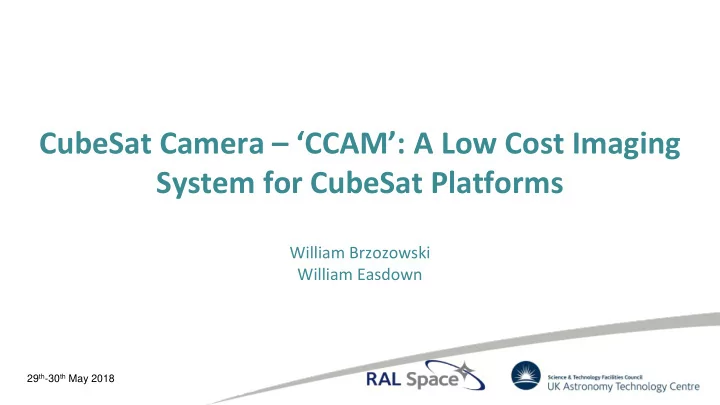

CubeSat Camera – ‘CCAM’: A Low Cost Imaging System for CubeSat Platforms William Brzozowski William Easdown 29 th -30 th May 2018
Contents • What is CCAM? • Design Drivers • Uses for CCAM • Detector Module • Optics Module • Optomechanics CCAM module • SNR challenges 29 th -30 th May 2018
What is CCAM? • UKATC and RAL Space collaboration - UKRI Optics Detector • Modular module module • Low cost • Optics module and detector module • 1.5U • 5m GSD at 400km Earth orbital height = (2.58 arcsec) • 2K x 2K detector • 2 ⁰ field of view 150mm • 1-2 year lifetime in Low Earth Orbit 29 th -30 th May 2018
CCAM Design Drivers • Off-the-shelf components • Compatibility with a 3 U CubeSat bus • RGGB Bayer pattern off-the-shelf CMOS detector and FPGA FPU design • Single aperture OT system mounted in the long axis of a 3U CubeSat • Image quality – NIIRS (National Image Interpretability Rating Scale) of level 2 [1] CCAM integrated into 3U cubesat structure 29 th -30 th May 2018
CCAM Uses • CCAM is ‘off the shelf’ – Quicker and cheaper to launch • Typical EO applications • Interplanetary observations: geological activity, meteoroid environments, weather systems or landscape mapping Shandong Peninsula in Eastern China taken by Landsat 8 [2] 29 th -30 th May 2018
CCAM Detector Module • 2048 x 2048 CMOS sensor • FPGA for module control • Memory included for buffering between FPU and OBC • Uses regulated 3V3 and unregulated 6V lines from CubeSat • All other voltages generated internally by low noise regulators • No more than 2A will be drawn from a single line • Overall power consumption around 6W CCAM detector module • 2/3fps frame rate • Blur minimised through 500µs exposures • A selection of power modes allow easy enabling/disabling of components for maximum performance or power saving • Utilises passive thermal control 29 th -30 th May 2018
CCAM Optics Module - Design 29 th -30 th May 2018
CCAM Optics Module - Performance • Diffraction limited RMS spot size across visible and NIR wavelength range • Pixel size for the CMOS sensor is 5.5 μ m • RMS wavefront error is diffraction limited across full field of view = 400nm = on axis field = 588nm = 900nm = off axis field = diffraction limit = diffraction limit = 700nm = max off axis field 29 th -30 th May 2018
CCAM Optomechanics Detector module Optics module • 3-point kinematic mount connecting modules – preserving optical alignment CMOS sensor • Can mount to numerous cubesat structures M2 • Passive thermal compensation features: -20 ⁰C < T < +60⁰C • Vibration dampeners to mitigate various NIR filter launch load vibration effects Field M1 correcting lens 29 th -30 th May 2018
SNR Challenge • SNR limited by: • Cubesat volume i.e. aperture size • CMOS sensor well capacity of 13500e ⁻ - limits dynamic range • Maximum possible exposure time ~500 μ s to avoid blur • Shot and readout noise • Dark current NIIRS level 2 reference image [3] • NIIRS level 2 achievable 29 th -30 th May 2018
SNR Challenge • Possible solutions: - Image stacking - Longer exposure time - Or using deployable apertures – UKATC deployable cubesat: Current testing of UKATC deployable cubesat Folded state Deployed state 29 th -30 th May 2018
Summary • Modular, low-cost imager for cubesat platforms • Resilient to space and launch environments • 3U or larger cubesats • FPGA and CMOS sensor • Diffraction limited reflective optics • High resolution • NIIRS level 2 29 th -30 th May 2018
Any Questions 29 th -30 th May 2018
References [1] https://fas.org/irp/imint/niirs.htm - accessed 22/05/18 [2] https://earthobservatory.nasa.gov/IOTD/view.php?id=91195&src=ve - accessed 23/05/18 [3] https://fas.org/irp/imint/niirs_c/append.htm - accessed 24/05/18 29 th -30 th May 2018
29 th -30 th May 2018
Further details • NIIRS level 2: • Identify large (i.e., greater than 160 acre) centre-pivot irrigated fields during the growing season. • Detect large buildings (e.g., hospitals, factories). • Identify road patterns, like clover leafs, on major highway systems. • Detect ice-breaker tracks. • Detect the wake from a large (e.g., greater than 300') ship. 29 th -30 th May 2018
Recommend
More recommend